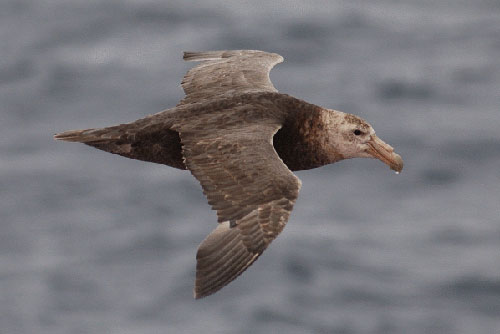Gabriel Blanco (Centro Nacional Patagónico, Puerto Madryn, Argentina) and colleagues have published in the journal Estuarine, Coastal and Shelf Science on the at-sea distribution of adult and juvenile Southern Giant Petrels Macronectes giganteus from Isla Arce and Isla Gran Robredo.
The paper’s abstract follows:
“The characterization of the seascape used by marine top predators provides a wide perspective of pelagic habitat use and it is necessary to understand the functioning of marine systems The goal of this study was to characterize the oceanographic and biological features of marine areas used by adult and first year juvenile southern giant petrels (SGP, Macronectes giganteus) from northern Patagonian colonies (Isla Arce and Gran Robredo) during the austral fall and winter (2005, 2006, 2007, and 2008). The marine environment exploited by the SGP was characterized using sea surface temperature (SST), SST gradients, chlorophyll-a concentration, water depth, oceanographic regimes, and ocean surface winds. In addition, the biological seascape was defined by considering the distribution of squid during the months of study. Juveniles SGP exploited a wide range of environments focusing mainly on productive neritic waters using a variety of oceanographic regimes. Juveniles were exposed to eutrophic and enriched waters, probably because of the frequent presence of thermal fronts in their utilization areas. Adults' environments lacked of thermal fronts remaining the majority of their time within the oceanographic regime “Continental Shelf”, in water depths of 100–200 m, exploiting mesotrophic and eutrophic environments, and remaining in areas of known food resources related to the presence of squid. For the most part, juveniles were exposed to westerly winds, which may have helped them in their initial flight to the shelf break, east of the colony. Wintering adults SGP also explored areas characterized by westerly winds but this did not play a primary role in the selection of their residence areas. Juveniles during their first year at sea have to search for food exploring a variety of unknown environments. During their search, they remained in productive environments associated to fronts and probably also associated to fisheries operating in their foraging areas. The understanding of pelagic birds' habitat selection and preferences through the year is crucial for the monitoring of anthropogenic impacts over these species. Further studies should focus on the prediction of variables that determine the distribution of these species though the year and during different life stages.”

Southern Giant Petrel at sea, photograph by Warwick Barnes
Reference:
Blanco, G.S., Pisoni, J.P. & Quintana, F. 2015. Characterization of the seascape used by juvenile and wintering adult Southern Giant Petrels from Patagonia Argentina. Estuarine, Coastal and Shelf Science 153: 135-144.
John Cooper, ACAP Information Officer, 18 February 2015

 English
English  Français
Français  Español
Español